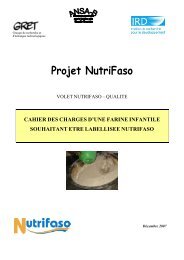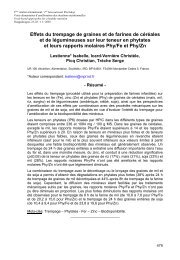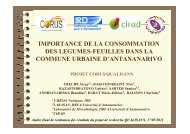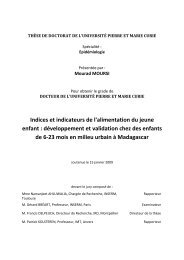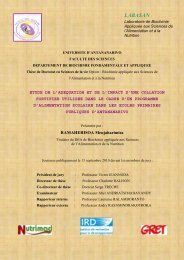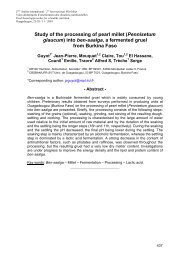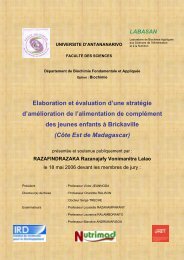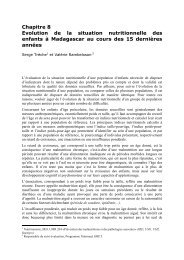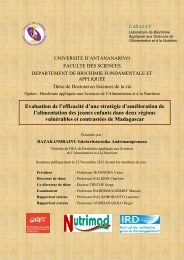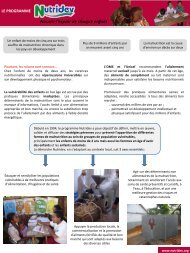THESE UNIQUE El Hassane Kéhien-Piho TOU - Nutridev
THESE UNIQUE El Hassane Kéhien-Piho TOU - Nutridev
THESE UNIQUE El Hassane Kéhien-Piho TOU - Nutridev
Create successful ePaper yourself
Turn your PDF publications into a flip-book with our unique Google optimized e-Paper software.
E.H. Tou et al. / International Journal of Food Microbiology 106 (2006) 52–60 55<br />
Table 1<br />
Mass balance of the ben-saalga processing in 24 TPUs<br />
Quantity (wet weight)<br />
TPU<br />
number (1)<br />
Mean<br />
value<br />
Standard<br />
deviation<br />
Min<br />
Max<br />
Pearl millet (kg) 24 6.8 3.9 1.4 18.0<br />
Drained, soaked millet (kg) 24 10.3 4.8 4.0 17.1<br />
Aromatics ingredients (g)<br />
Ginger 19 272 180 94 725<br />
Black pepper 11 22 16 4 49<br />
Pepper 10 18 13 6 45<br />
Mint 10 52 39 8 128<br />
Intermediary products (kg)<br />
Humid flour 24 12.3 8.0 2.0 29.5<br />
Discarded draff 24 4.0 2.2 0.5 8.4<br />
Unfermented sieved paste 24 23.4 19.0 9.7 45.1<br />
Fermented paste 24 8.4 1.9 3.0 15.3<br />
Water used during the<br />
process (kg)<br />
Washing 17 14.9 10.2 4.8 39.2<br />
Soaking 24 10.0 5.7 3.3 25.4<br />
Kneading 24 38.2 24.1 9.9 107.0<br />
Filtration 24 35.2 19.0 9.9 70.7<br />
Settling 24 34.5 19.1 9.9 70.7<br />
Cooking 14 15.3 9.7 1.8 32.7<br />
(1): number of traditional producing units (TPU) where the values were<br />
registered. When this number is inferior to 24, this means that this is a<br />
facultative operation of the processing. Min: minimum value, Max: maximum<br />
value.<br />
sometimes the germs of the millet grains and are used for<br />
animal feed. Cooking was the final step of millet processing<br />
into gruels (ben-saalga or ben-kida). First the supernatant<br />
resulting from the settling step was collected and heated for<br />
40 min close to boiling point (Fig. 1 and Table 2).<br />
Afterward, the paste was added to the supernatant and<br />
boiled for 7 min. After boiling the supernatant, some<br />
producers added granules obtained by rolling wet millet<br />
flour. When the granules are added to ben-saalga, the gruel<br />
is called ben-kida (a granular gruel in mooré). However,<br />
only ben-saalga is used as a complementary food, and<br />
whatever the type of gruel produced, the ben-saalga flow<br />
diagram is always the same and so the production of benkida<br />
can be considered as a variant.<br />
Titratable acidity, temperature and pH of the products of<br />
fermentation steps and ben-saalga are shown in Table 2. A<br />
decrease in pH was observed during the soaking and settling<br />
steps (from 6.4 to 4.4 and from 5.5 to 3.7, respectively) and<br />
suggests that both steps are in fact fermentation steps. In<br />
addition, the biggest increase in titratable acidity was observed<br />
during the settling step.<br />
During processing there was a considerable decrease in<br />
IP6, raffinose and sucrose contents, 75%, 83% and 99%,<br />
respectively (Table 3). In addition, protein content decreased<br />
from 10.2 g/100 g DM in the grains to 6.0 g/100 g DM in<br />
the fermented paste. This decrease was due to the elimination<br />
of some protein rich fractions contained in the draff during<br />
the sieving step. The DM content in the gruels was low,<br />
corresponding to very low energy density (about 30 kcal/100<br />
g of gruel before the addition of sugar). The consistency of<br />
the gruel was rather thin and the mean value of Bostwick<br />
flow was 137 mm/30 s (ranging from 99 to 180 mm/30 s).<br />
The mean value of the pH of gruels was 3.9 (values ranged<br />
from 3.6 to 4.0).<br />
3.2. Kinetics of pH changes during the soaking and settling<br />
steps<br />
Changes in pH were continuously measured on-line using a<br />
pH-meter register during the soaking and settling steps in<br />
8 TPUs (Fig. 2).<br />
During the soaking step, similar acidification profiles were<br />
observed in all TPUs except for two where soaking was<br />
stopped after a shorter period by the producers (Fig. 2). pH<br />
decreased in two phases. In the first phase (0 to 6 h) the average<br />
pH decreased from an initial value of 6.6 to 5.3. In the second<br />
phase (5 to 8 h) the pH decreased from 5.3 to 4.4.<br />
In the settling step, initial pH varied with the TPU but in<br />
general the decrease in pH followed a similar and classical<br />
pattern (Fig. 2) and stopped between 5 and 6 h to reach a mean<br />
final value of 3.9 (maximum: 4.0; minimum: 3.6). There was<br />
no apparent relation between the pH at the end of the soaking<br />
step and the initial pH at the settling step. The differences<br />
observed in the initial pH at the settling step in different TPUs<br />
might be due to the time spent between the grinding in the<br />
community milling units and the beginning of the settling step<br />
at the TPU, which can vary (duration of transportation between<br />
the TPU and the community unit, time spent waiting for<br />
grinding, etc.).<br />
3.3. Fermentation kinetics in pilot scale experiments and in<br />
TPUs<br />
As soaking and settling were identified as the two<br />
fermentation steps, these steps were investigated in more detail<br />
to better characterize consumption of substrates and the<br />
formation of products.<br />
Table 2<br />
pH, titratable acidity and temperature of the products during the fermentation<br />
steps in 24 TPUs<br />
Mean value Standard Min a Max a<br />
deviation<br />
pH<br />
Water at the beginning of soaking 6.4 0.5 5.09 6.95<br />
Water at the end of soaking 4.4 0.5 3.63 5.88<br />
Wet flour after sieving 5.6 0.8 4.09 6.66<br />
Supernatant at the beginning of 5.5 0.8 4.10 6.53<br />
settling<br />
Supernatant at the end of settling 3.7 0.2 3.39 4.46<br />
Fermented paste obtained after<br />
settling<br />
4.0 0.4 3.45 4.75<br />
Titratable acidity (mmol of lactic acid/100 g wet matter)<br />
Wet flour after sieving 108.9 69.1 24.8 306.1<br />
Fermented paste obtained after<br />
settling<br />
341.4 113.4 171.1 570.3<br />
Temperature (-C)<br />
Supernatant during cooking 98.6 1.2 97.0 99.9<br />
Ben-saalga during cooking 89.2 3.6 81.4 93.3<br />
a Min: minimum value, Max: maximum value.



